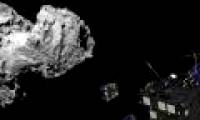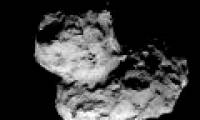
In 2004, the European Aviation Agency (ESA) launched an ambitious space mission named Rosetta.

In 2015, scientists announced the discovery of oxygen molecules on comets 67P / Churyumov-Gerasimenko, based on the observations of Rosetta spacecraft.

Scientists are preparing to farewell the spacecraft to probe the Rosetta comet when the device hits the comet, ending the 12-year mission in the universe.

Scientists discovered that the probe robot Philae was stuck in the crack in the comet through a photograph of Rosetta's mother ship.

Scientists from the German Space Agency (DLR) give up hope to restore contact with space exploration robots Philae because its solar panels have stopped working.

The Rosetta spacecraft took 10 years to cross the journey of more than 6 billion km to bring the robot Philae to land and study comets 67P / Churyumov-Gerasimenko.

The Rosetta spacecraft, currently in a trawl around comet 67P / Churyumov - Gerasimenko, has detected 120 light spots on the comet surface with an area of at least 2m.

Philae probe robot on comet has

Last month, the landing craft of Philae marked an important milestone in the history of aerospace industry, when it first landed on the surface of a comet.

Data from the Rosetta spacecraft and the Philae robot show that comets do not bring water to the earth in the past as the scientific community previously determined.
 In 2004, the European Aviation Agency (ESA) launched an ambitious space mission named Rosetta.
In 2004, the European Aviation Agency (ESA) launched an ambitious space mission named Rosetta. In 2015, scientists announced the discovery of oxygen molecules on comets 67P / Churyumov-Gerasimenko, based on the observations of Rosetta spacecraft.
In 2015, scientists announced the discovery of oxygen molecules on comets 67P / Churyumov-Gerasimenko, based on the observations of Rosetta spacecraft. Scientists are preparing to farewell the spacecraft to probe the Rosetta comet when the device hits the comet, ending the 12-year mission in the universe.
Scientists are preparing to farewell the spacecraft to probe the Rosetta comet when the device hits the comet, ending the 12-year mission in the universe. Scientists discovered that the probe robot Philae was stuck in the crack in the comet through a photograph of Rosetta's mother ship.
Scientists discovered that the probe robot Philae was stuck in the crack in the comet through a photograph of Rosetta's mother ship. Scientists from the German Space Agency (DLR) give up hope to restore contact with space exploration robots Philae because its solar panels have stopped working.
Scientists from the German Space Agency (DLR) give up hope to restore contact with space exploration robots Philae because its solar panels have stopped working. The Rosetta spacecraft took 10 years to cross the journey of more than 6 billion km to bring the robot Philae to land and study comets 67P / Churyumov-Gerasimenko.
The Rosetta spacecraft took 10 years to cross the journey of more than 6 billion km to bring the robot Philae to land and study comets 67P / Churyumov-Gerasimenko. The Rosetta spacecraft, currently in a trawl around comet 67P / Churyumov - Gerasimenko, has detected 120 light spots on the comet surface with an area of at least 2m.
The Rosetta spacecraft, currently in a trawl around comet 67P / Churyumov - Gerasimenko, has detected 120 light spots on the comet surface with an area of at least 2m. Philae probe robot on comet has
Philae probe robot on comet has Last month, the landing craft of Philae marked an important milestone in the history of aerospace industry, when it first landed on the surface of a comet.
Last month, the landing craft of Philae marked an important milestone in the history of aerospace industry, when it first landed on the surface of a comet. Data from the Rosetta spacecraft and the Philae robot show that comets do not bring water to the earth in the past as the scientific community previously determined.
Data from the Rosetta spacecraft and the Philae robot show that comets do not bring water to the earth in the past as the scientific community previously determined.









 One of the loneliest species on Earth, living 2,800m underground and surviving on radioactive energy
One of the loneliest species on Earth, living 2,800m underground and surviving on radioactive energy The meaning of Christmas tree lighting ceremony
The meaning of Christmas tree lighting ceremony Earth's inner core is 'deforming' discovered
Earth's inner core is 'deforming' discovered 5 special objects on the NASA robot that landed on Mars
5 special objects on the NASA robot that landed on Mars Woolly mammoths turned out to be a staple diet for prehistoric North Americans
Woolly mammoths turned out to be a staple diet for prehistoric North Americans Can humans travel forward or backward in time?
Can humans travel forward or backward in time? Finding the mysterious 'monster' that is making the universe expand
Finding the mysterious 'monster' that is making the universe expand How long is the flight to the Moon?
How long is the flight to the Moon?